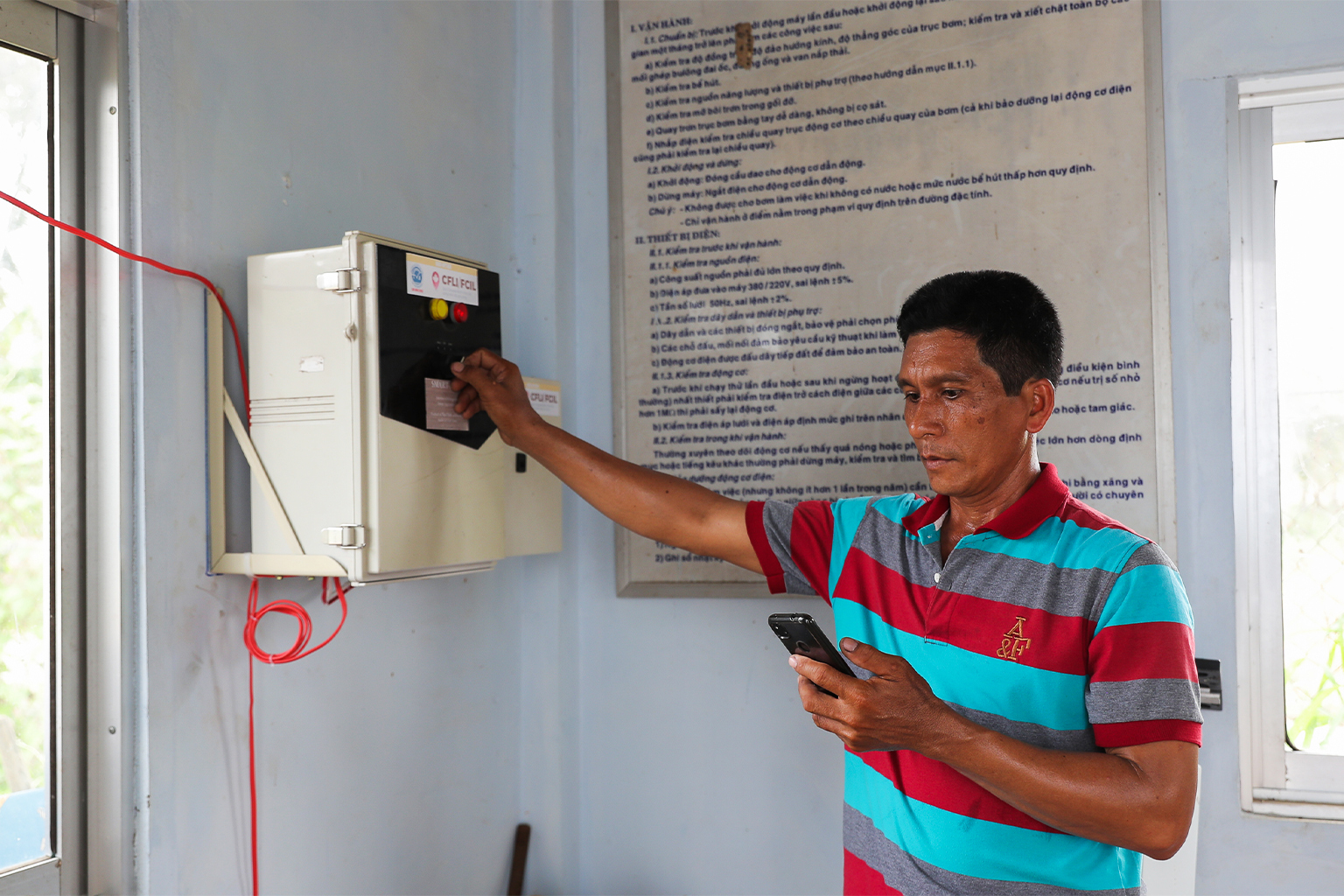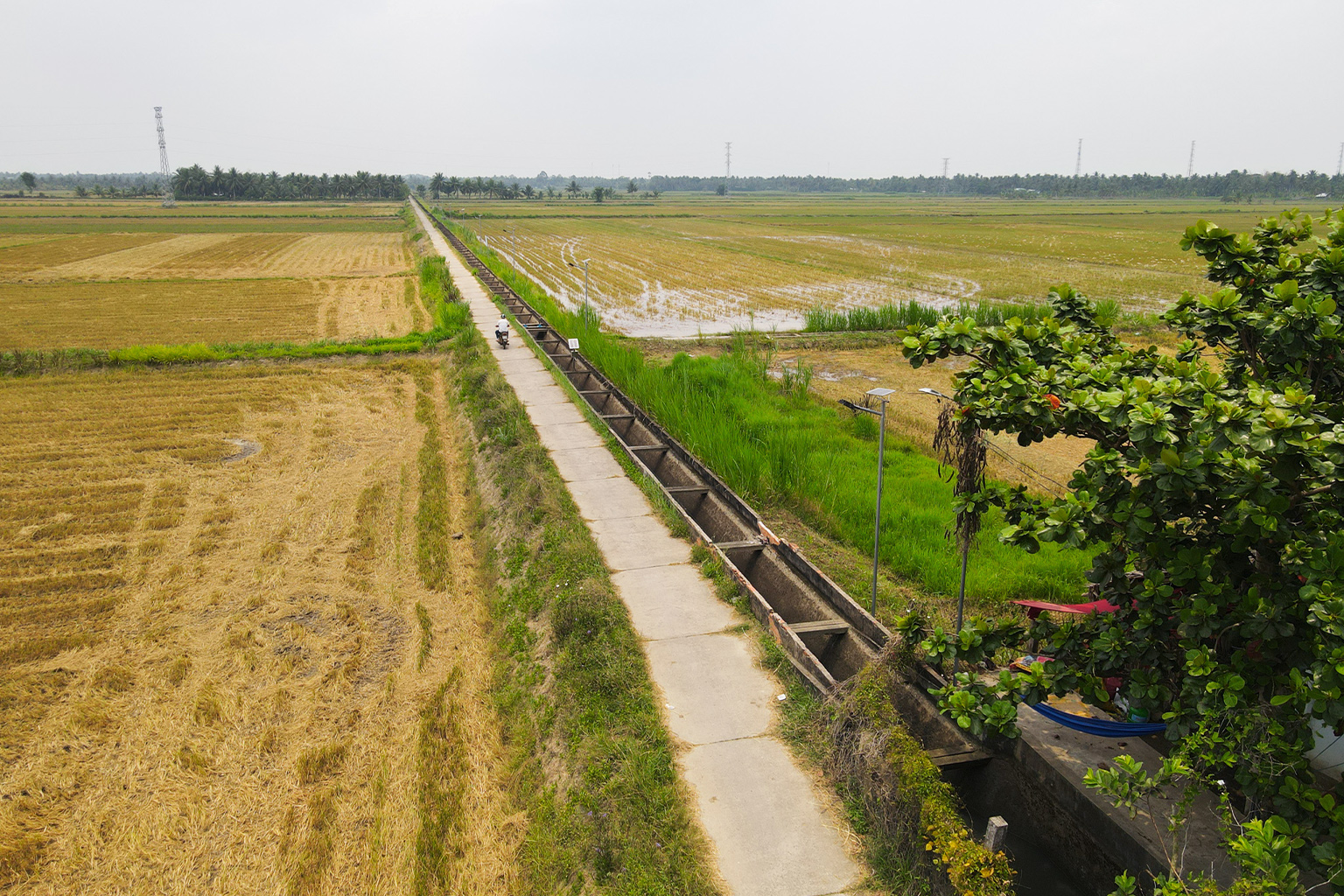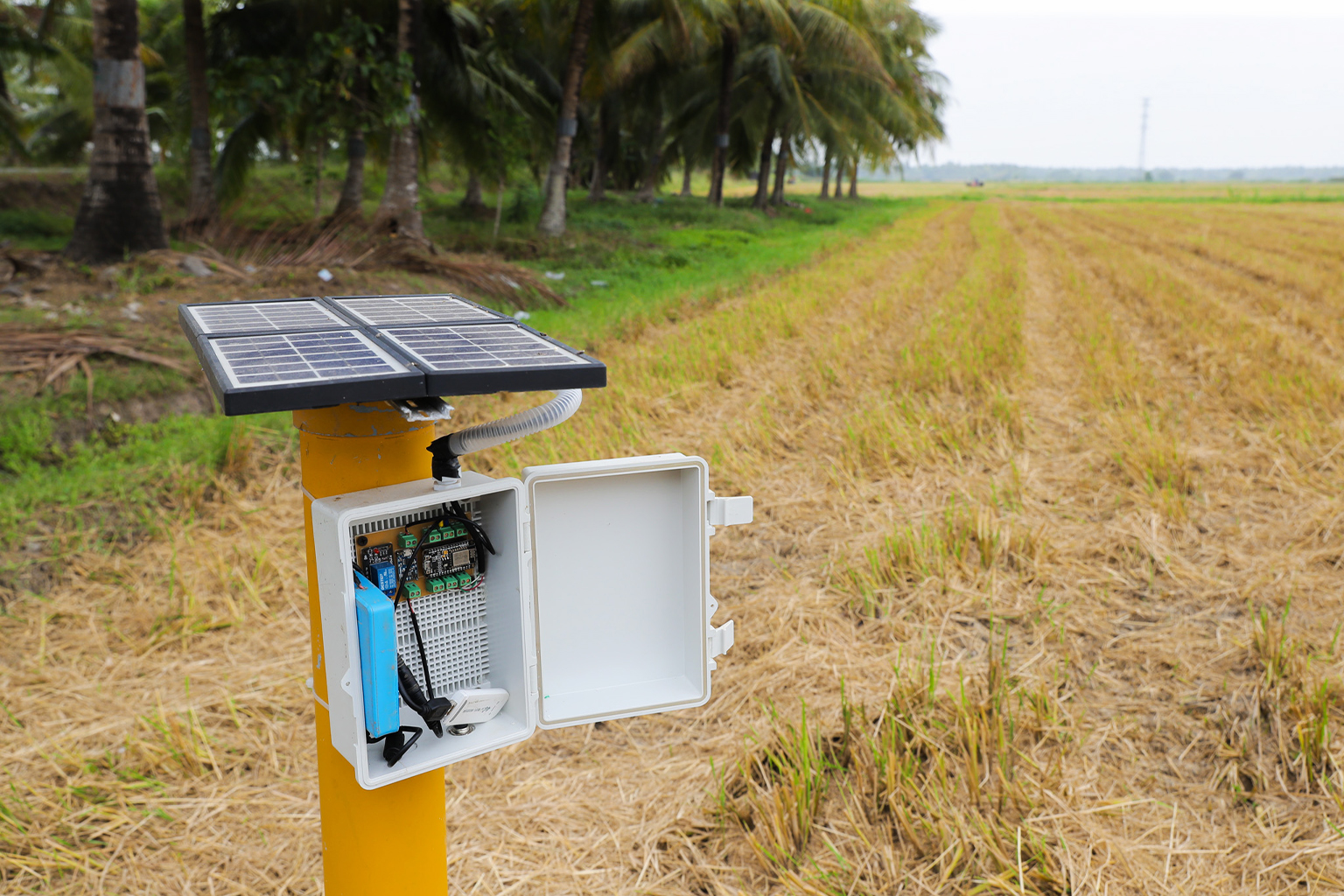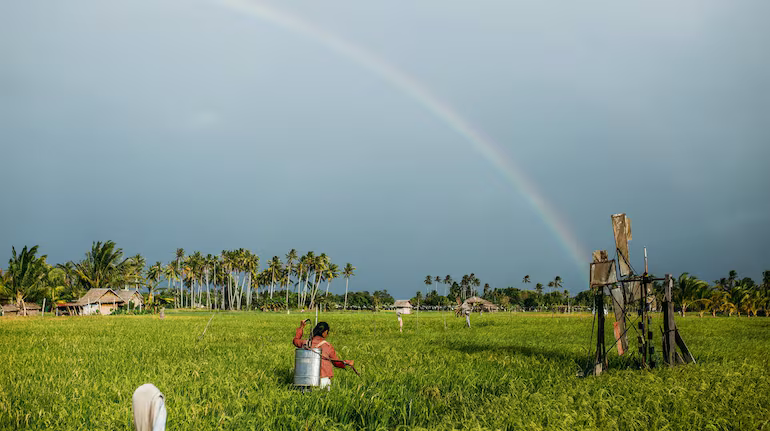Tags
Vietnamese rice farmers go high-tech to anticipate a low-water future
- Since the 1970s, Vietnam’s “rice-first” policy facilitated the construction of an elaborate series of dikes and dams that allowed farmers in the Mekong Delta to flood their fields to allow for multiple harvests per year.
- Now, in the face of climate change impacts, seawater intrusion, upstream dams and new government policies that mandate water conservation, farmers in the delta need to find ways to reduce their water consumption.
- In one pilot project, university researchers have teamed up with local farmers to implement a technique called alternate wetting and drying (AWD), supported by a smartphone application that allows farmers to save water and reduce emissions.
TRA VINH, Vietnam — In the heat of Tra Vinh’s dry season, rice farmer Thach Ren stands on a recently harvested field holding a smartphone. The once lush and green field now lies barren, peppered with rice husks. Ren, 43, who has witnessed the ever-changing land and waterscapes of the Mekong, is one of a small group of farmers experimenting with a new way of growing rice.
Ren is a member of the Phu Can farming cooperative, one of three co-ops in a pilot project with a local university. As government policy and a rapidly changing climate bear down on Vietnamese rice farmers, especially in terms of their access to water, this project could provide them a way forward without forcing them to abandon their way of life.
Now, with a simple press of a button, Ren can tap into a network of sensors and water pumps, connecting him directly to his fields and helping him to reduce the amount of water he needs to grow rice.
“I only need to press the power button … to check the water level on the field,” Ren says.

Vietnam is one of the world’s most prolific rice-producing nations. A checkerboard landscape of emerald-green and golden-brown fields holds generations’-old crops. But now, with climate change affecting the land and waterways, this timeless scene is changing fast.
Ren sees evidence of this every day. He’s been growing rice in Vietnam for more than 20 years, and says it’s time to take a chance on something new.
“I’m tossing the coin, trying out a new technique,” he says.
That new technique is called “alternate wetting and drying,” or AWD. Facing freshwater scarcity and rising levels of salinity, academics and farmers are working together to implement a method of rice farming that uses less water.
For the past half century, rice growing in Vietnam’s Mekong Delta has been a water-intensive process, with an elaborate network of dikes and canals allowing multiple harvests per year. But as the waterscape of the delta becomes increasingly unstable due to drought, sand dredging, rising sea levels and upstream hydropower dams, the Vietnamese government is calling on farmers like Ren to use more sustainable irrigation methods.
By 2030, it plans to limit access to freshwater via the canals traditionally used by farmers, posing a challenge for communities that have long used the technique of flooding their fields.

Supported by Tra Vinh University, (TVU), farmers in the Phu Can cooperative are experimenting with a technique that allows them to produce the same amount of rice while using up to 20% less water.
Ren was among the first farmers to join the pilot project, and he says now he only needs to pump water three to four times per season, compared to the traditional method where he would need to pump water every time the soil’s surface became a little dry — which was typically about 10 times per season.
“The difference in terms of productivity is small, but the new method costs way less compared to the old framework,” Ren says.
While farmers in Vietnam pay for water by area, not volume, the costs of electric pumps can be high.
Nam Dung has spent his whole life farming, “since the day I could hold the pickaxe.” The 46-year-old got involved in the pilot project after hearing about it in the news. He had tried a version of AWD years before, but never quite got the hang of it. But this time, it seems to be working.
“Not only can we save water but also reduce fees on the water pump. We can also decrease the amount of fertilizer needed, boost our crop yield, and prevent the rice plants from collapsing and destroying the entire crop,” Dung says.


AWD in action
Alternate wetting and drying involves flooding and draining rice fields in quick rotation. Instead of being continuously flooded, the rice field is left to dry for a number of days before being flooded again. Farmers need to closely monitor their fields to determine when to reflood, aiming to use the least amount of water to keep the plants healthy.
AWD has been tested and used in rice-producing regions around the world for decades, including the province of An Giang in Vietnam, but is new for farmers in this area of the Mekong Delta. Convincing farmers to switch to a new, and potentially more labor-intensive, form of irrigation takes years of work.
The TVU researchers have created an app-based technology that could make AWD easier to implement so that farmers don’t have to constantly watch their fields. With funding from the World Bank and the Canadian government, each AWD plot is equipped with a solar-powered sensor that takes a reading of the underground water level every five minutes.
This reading is transmitted in real time to cloud-based software, which then sends recommendations to farmers via the app, allowing them to control water levels in their field without having to be there in person.
“If I get caught up with other stuff and can’t go to the field, I just need to open the app and check the stats there,” Dung says. “I can be anywhere and press a button.”
The researchers launched this project after the worst drought in more than a century hit southern Vietnam in 2016, devastating farms in the delta. Since then, drought and saltwater intrusion have worsened.
Dams in countries upstream on the Mekong River, coupled with the widespread mining of sand, which is used to make products like concrete and asphalt, have changed the waterscape, allowing for seawater to seep up from the ocean into rice fields across Vietnam.
In 2017, the TVU team began teaching farmers how to implement AWD in training seminars. Diep Thanh Tung is one of the lead academics behind what he refers to as TVU’s “farmer field school.” The initiative was carried out in three regions: Tra Vinh, Can Tho and An Giang.
“This area is affected a lot, especially for rice production,” Tung says. “[The farmers] will lose 100% if they don’t know how to deal with that situation.”
“As scientists, we thought we had to do something,” says Pham Vu Bang, a TVU researcher who works alongside farmers in the field. “We understood that the alternate wetting and drying unification technique … has a lot of benefits. Environmental benefits, for example, saving water, greenhouse gas emission reduction. And also, it’s very good for the crop of rice.”
The technique is shown to reduce greenhouse gas emissions by 30-50%. Methane produced from growing rice accounts for 12% of global emissions of methane, a much more potent greenhouse gas than carbon dioxide.
“Rice has a standing water layer in the field. No other crop has that. And with that water layer, there’s no exchange between air and soil,” says Bjoern Ole Sander, a senior scientist at the International Rice Research Institute. When combined with oxygen, a methane-emitting bacteria forms in the water layer. But by breaking that layer of standing water using AWD, farmers can grow the same amount of rice without the bacteria — and thus with less emissions.
Lam Thi Kinh The has been farming with the cooperative for more than 10 years. She joined the pilot project and attended farmer field school training seminars with TVU researchers after seeing the benefits of AWD.
“People from Tra Vinh University come over to instruct us farmers on how to grow rice,” Lam says.
“It allows us to cut back resources. That is the reason why we farmers agree to follow the methods.”


One of the many solar-powered sensors that Tra Vinh University placed around the Phu Can Cooperative’s rice fields. These sensors provide the water level to an app farmers can check from their smartphones, allowing them to only water the fields exactly when they need to. Image by Giang Pham.
Why now?
In 2017, the Vietnamese government introduced agricultural reforms through Resolution 120, a policy plan that calls for sustainable growing methods. This marked a change of course for a nation that for decades prioritized rice production.
Vietnam’s rice-first policy was introduced in the 1970s to address domestic food insecurity following the U.S. war in the country. The government constructed dikes throughout the Mekong Delta, allowing for year-round rice production. The focus on building up infrastructure to expand rice farming led the country to become the world’s second-largest rice exporter by 1989, after Thailand.
But the dikes changed the natural flow of the water, wiping out sediment and leaving Vietnam even more vulnerable to climate change impacts.
In 2022, the government created a master plan for the Mekong Delta, aiming to continue rice production while shifting the focus from higher export volumes to higher quality. The goal is to cut GHG emissions, improve efficiency while diversifying production, and implement reforms to the dike system by 2030.
“It means that the agriculture sector in the Mekong Delta has to be restructured,” Vu Bang says.
Many farmers are diversifying by growing multiple crops, such as fruits and vegetables, or cultivating shrimp.
“But not all farmers can convert … there’s no way for them to uptake other farming systems, no way for them to have shrimp, the only livelihood they have is rice,” Vu Bang says.

Scaling up AWD
Even with a push from the government to reduce water usage, switching to AWD isn’t easy for all farmers.
“On average, farmers in the Mekong Delta have only 0.5 hectares [about 1 acre] per household,” Sander says. “The area is very small, and they need to invest in the same system. So it’s not cost-effective.”
Researchers found that the app-sensor technology used in the pilot project was too expensive to implement on a small scale. But since sensors have become less expensive, he says the technology will become more accessible in the near future.
“The whole climate question is much more pressing now. It’s more pressing for policymakers and the international communities, so there may also be more funding available for these kinds of technologies,” he says.
Sander adds that for AWD to be successful, even without app-sensor technology, it needs to be implemented on a larger scale.
“It’s difficult to work with only a few hand-picked farmers to try to introduce AWD because if all the surrounding fields are flooded, it will be difficult to really manage AWD,” he says.
And without a widespread rollout, the smaller plots can succumb to pests like mice and rats that will feast in the dry rice fields, avoiding the flooded fields of their neighbors.
Ren, like many farmers in the delta, has relied on the common practice of flooding the field to keep the rats out.
“But now, it turns out that if we leave the field dried out, the rats can just munch on the snails and crabs, so it helps too,” he says.


The future of AWD
Participating in the pilot project was a leap of faith on the part of farmers like Ren. Now, with climate change altering the Mekong Delta’s waterscapes, innovation is becoming a necessity.
“Water becomes more and more scarce, in many areas, due to more urban use, more industrial use, [and] due to more unpredictable rainfall patterns” Sander says.
“I think that non-continuously flooded rice production is the future everywhere.”
Short Summary
Alternate Wetting and Drying (AWD), a water-saving method created by Tra Vinh University and backed by smart technology, is being adopted by rice farmers in Vietnam’s Mekong Delta. Farmers like Thach Ren utilize solar-powered pumps and smartphone-connected sensors to monitor and control irrigation in response to government water conservation measures, seawater intrusion, and climate change.
Additional reporting by Sen Nguyen and Giang Pham.
Banner image: In this December 2022 image, a rice farm in Tra Vinh, Vietnam, is almost ready for harvest. Flooded ankle-deep, these farms need a significant amount of water to keep the rice crops submerged throughout the growing period. Image by JJ Mazzucotelli.
This story was produced in partnership with fellows of the Global Reporting Program at the University of British Columbia’s School of Journalism, Writing, and Media. Mongabay retained full editorial control of the published article.
https://news.mongabay.com/2023/07/vietnamese-rice-farmers-go-high-tech-to-anticipate-a-low-water-future/Published Date: July 25, 2023






